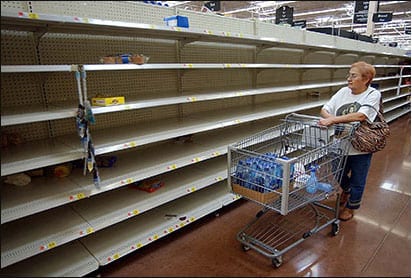Global food shortages have intensified, driven by ongoing conflicts and significant disruptions in supply chains. The United Nations’ 2025 Global Report on Food Crises highlights a record level of acute food insecurity and child malnutrition in 2024, marking six consecutive years of deterioration. Over 295 million people across 53 countries experienced crisis-level hunger, a 5% increase from 2023. The primary drivers of this crisis are conflicts, climate-related disasters, and economic shocks, which often intersect. Notably, conflict alone affected nearly 140 million people, with famine conditions confirmed in Sudan and catastrophic hunger levels in Gaza, South Sudan, Haiti, and Mali. Economic instability, including inflation and currency devaluation, pushed 59.4 million into food crises, while extreme weather, exacerbated by El Niño, impacted 96 million people. Alarmingly, the number of people in famine-like conditions doubled to 1.9 million, and 38 million children under five were acutely malnourished. The situation is expected to intensify in 2025 due to significant cuts in humanitarian food aid, including a drastic reduction by the U.S. Agency for International Development. However, there were improvements in 15 countries thanks to aid and improved conditions. The report advocates investing in local agriculture as a sustainable solution to reduce hunger cost-effectively and with dignity. (reuters.com)
The World Food Programme (WFP) has warned that funding shortages may halt global child malnutrition programs in countries like Yemen, Afghanistan, and Syria within months if urgent funds are not secured. Cindy McCain, WFP’s Executive Director, emphasized the critical need for action to prevent lifelong suffering for millions of children. The United States, the largest donor to WFP, has paused foreign aid while reviewing its “America First” policy, significantly impacting WFP’s budget. The organization requires $1.4 billion for its nutrition programs in 2025, aiming to assist 30 million mothers and children in 56 countries affected by war, economic instability, and climate change. Without additional funding, programs in Yemen could cease in May, with reductions in Syria, Afghanistan, and Congo by June. WFP also anticipates cuts in food rations for Rohingya refugees, exacerbating concerns over rising hunger in overcrowded camps. (reuters.com)
Climate disasters are increasingly affecting global food supply chains, causing significant price hikes in essential food items. Severe droughts in the Mediterranean have reduced olive harvests in Spain, increasing olive oil prices by 27% for American consumers. Similarly, extreme weather affecting cocoa farmers in Ghana and Ivory Coast has driven chocolate prices in Australia up by 200%, with similar trends expected in the U.S. Wheat production has also been severely impacted by droughts in Argentina, further exacerbated by the Russia-Ukraine conflict, leading to notable volatility in wheat prices. This impacts consumer budgets, especially in low-income households worldwide, forcing shifts to cheaper and less nutritious food options. Addressing this issue requires a global cooperative effort to build resilience in food supply chains. Proposals include launching supply chain climate adaptation plans (S-CAPs) led by multilateral organizations, governments, and private sector companies, focused on identifying vulnerable supply chains and developing strategies to mitigate risks. International collaboration and investment in such initiatives can yield high returns and help stabilize food prices, ensuring food security in the face of climate change. (time.com)
Weeks into President Trump’s newly initiated trade conflict, tensions between the U.S. and China are already causing significant disruptions in global supply chains. Experts warn that even if the trade war ended immediately, the cascading effects could persist for months or even years. PwC’s Bryan Gross describes the current period as one of “unprecedented disruption,” with imbalances already observable in commerce. Retail CEOs and economists caution that the U.S. could face shortages reminiscent of the COVID-19 pandemic within two to three weeks due to the near-embargo state with China. These disruptions are impacting how businesses forecast demand, allocate capital, and place orders—lengthy processes that cannot rapidly adapt to sudden supply shocks. Although Treasury Secretary Scott Bessent claims that retailers had anticipated tariff-related issues, experts warn that supply shocks can quickly evolve into demand shocks, intensifying the economic strain. As the challenges mount, the urgency to resolve the situation is growing, with the metaphorical “clock ticking loudly.” (axios.com)
The Red Sea crisis, initiated by the Iran-backed Houthi movement in Yemen on October 19, 2023, has further exacerbated global food shortages. The Houthis launched missiles and armed drones at Israel, demanding an end to the invasion of the Gaza Strip. Since then, they have seized or bombarded dozens of merchant and naval vessels in the Red Sea, leading to retaliatory airstrikes by U.S. and allied forces. This conflict has significantly disrupted shipping routes, particularly in the Bab-el-Mandeb Strait, a critical passage for global trade. By March 2024, over 2,000 ships had been rerouted to sail around South Africa, adding significant time and cost to global shipping. The suspension of a large volume of trade through the Red Sea led to a decrease in the use of the Suez Canal, impacting economies that rely on this route, including Egypt. The crisis has also affected global supply chains, with companies like Maersk estimating a capacity loss of 15–20 percent across the industry due to the Red Sea crisis. (en.wikipedia.org)
In summary, the convergence of conflicts, climate change, and economic instability has led to a significant global food crisis. The United Nations reports record levels of acute food insecurity and child malnutrition, with over 295 million people affected. Funding shortages threaten to halt essential child malnutrition programs, and climate disasters are causing significant price hikes in essential food items. Trade conflicts, such as the U.S.-China tensions, are causing unprecedented disruptions in global supply chains, and regional conflicts like the Red Sea crisis are further exacerbating the situation. Addressing these challenges requires coordinated international efforts to stabilize food prices, ensure supply chain resilience, and provide humanitarian assistance to those in need.












Leave a comment